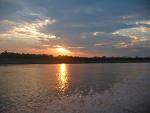
It is located in northeastern Peru, politically part of the Loreto region covers parts of the provinces of Requena Alto Amazonas and Ucayali. In depression Ucamara precisely at the confluence of great rivers Ucayali and Marañon, where the limit. The southwestern part is delimited by a strip of low hills that form the watershed of the river Huallaga.
The name of the Pacaya-Samiria comes from the name of the two rivers that run through it: the river and the river Samiria Pacaya. The Reserve has a singular beauty, being also called the "Forest of Mirrors" because the forest and the sky are reflected so clearly in the dark waters of its rivers, which the visitor has the feeling of browsing without mirrors end.
It is a vast complex of alluvial terraces and flood plains where there are freshwater lakes, ponds and seasonally flooded forested wetlands. The Reserve has an area of 2'080, 000 hectares which represents 1.5% of the total land area, and is the second largest protected natural area of Peru, also, and the second between the Amazonian countries and the fourth in South America. It is the largest floodplain forest in the Amazon, subject to state protection.
The Reserve occupies three watersheds, the rivers Samiria Yanayacu Pacaya, and bounded on the north by the Maranon and the Ucayali River south. It has a typical tropical climate: hot and humid, with temperatures often exceed 34 ° C.
Its hydrography and dynamics of growing and dry season river, allows for a high diversity of flora and fauna, as well as a wealth of aquatic life. So far there have been 443 species of birds, 97 mammals, 55 amphibians, 259 fish and 1039 species of plants. Stresses the great expanse of forest that remain flooded much of the year, highlighting the "forest of water source" or "palm swamps and mixed forests of palm trees. The "pungales" and "renacales" are other vegetation that make it unique landscape in this part of the Amazon.
It is advisable to visit this beautiful reserve interlaced months from May to October.















